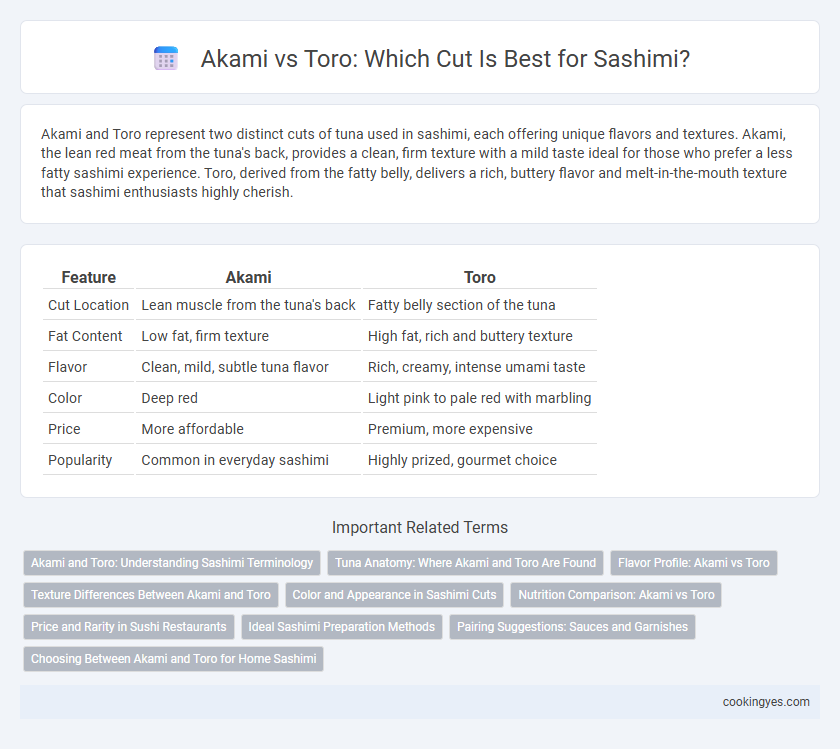Akami and Toro represent two distinct cuts of tuna used in sashimi, each offering unique flavors and textures. Akami, the lean red meat from the tuna's back, provides a clean, firm texture with a mild taste ideal for those who prefer a less fatty sashimi experience. Toro, derived from the fatty belly, delivers a rich, buttery flavor and melt-in-the-mouth texture that sashimi enthusiasts highly cherish.
Table of Comparison
| Feature | Akami | Toro |
|---|---|---|
| Cut Location | Lean muscle from the tuna's back | Fatty belly section of the tuna |
| Fat Content | Low fat, firm texture | High fat, rich and buttery texture |
| Flavor | Clean, mild, subtle tuna flavor | Rich, creamy, intense umami taste |
| Color | Deep red | Light pink to pale red with marbling |
| Price | More affordable | Premium, more expensive |
| Popularity | Common in everyday sashimi | Highly prized, gourmet choice |
Akami and Toro: Understanding Sashimi Terminology
Akami refers to the lean, red muscle part of the tuna, prized for its firm texture and mild flavor, making it a popular choice for sashimi. Toro, found in the fatty belly of the tuna, is known for its rich, buttery taste and marbled appearance, often considered the most luxurious sashimi cut. Understanding the distinction between Akami and Toro is essential for sashimi enthusiasts seeking varied flavor profiles and textures in authentic Japanese cuisine.
Tuna Anatomy: Where Akami and Toro Are Found
Akami and Toro are distinct tuna cuts found in different parts of the fish, with Akami sourced from the lean, red muscle along the sides, offering a firm texture and rich umami flavor. Toro, on the other hand, comes from the fatty belly section, prized for its creamy texture and higher fat content, divided into Chutoro (medium fatty tuna) and Otoro (the fattiest, most marbled part). Understanding tuna anatomy is essential for appreciating why Akami and Toro vary significantly in taste and texture, reflecting their positions within the tuna's body.
Flavor Profile: Akami vs Toro
Akami sashimi, sourced from the leaner part of the tuna, offers a clean, robust flavor with a firm texture and subtle umami notes, making it a popular choice for those seeking a more straightforward taste experience. Toro, derived from the fatty belly portion, delivers a rich, buttery flavor profile with a melt-in-your-mouth texture, characterized by its higher fat content and pronounced sweetness. The contrast between Akami's savory intensity and Toro's creamy richness highlights the diverse sensory appeal of premium sashimi cuts.
Texture Differences Between Akami and Toro
Akami, the lean red meat from the back of the tuna, offers a firm, slightly fibrous texture prized for its clean, muscular bite. Toro, derived from the fatty belly, boasts a rich, buttery texture that almost melts in the mouth, providing a creamy sensation absent in Akami. These distinct textural contrasts define their unique appeal in sashimi, with Akami favored for its robustness and Toro prized for its luxurious softness.
Color and Appearance in Sashimi Cuts
Akami sashimi features a deep red color with a firm texture, indicative of its lean muscle content, making it visually vibrant and appealing. Toro sashimi, including both chutoro and otoro, displays a lighter pink to pale red hue with visible marbling of fat, giving it a glossy, buttery appearance. The contrast in color and marbling between akami and toro highlights their distinct quality levels and flavor profiles in sashimi presentation.
Nutrition Comparison: Akami vs Toro
Akami, the lean red meat from the tuna's back, is rich in protein and low in fat, making it a nutritious choice with fewer calories and higher iron content. Toro, the fatty belly portion, contains more omega-3 fatty acids, offering heart-healthy benefits but also higher saturated fat and calorie levels. Choosing between Akami and Toro depends on nutritional goals, balancing lean protein intake versus healthy fats.
Price and Rarity in Sushi Restaurants
Akami, the lean red part of tuna, is more affordable and commonly found in sushi restaurants due to its higher availability and lower fat content. Toro, especially Otoro from the belly, is significantly rarer and commands a premium price because of its rich marbling and melt-in-mouth texture. Sushi chefs often reserve Toro for special occasions, reflecting its status as a luxury sashimi cut prized for exclusivity and flavor.
Ideal Sashimi Preparation Methods
Akami, the lean red meat from the tuna's back, requires precise slicing at a slight angle to preserve its firm texture and clean flavor, commonly served chilled to enhance freshness. Toro, the fatty belly portion, benefits from thinner cuts that emphasize its rich marbling and buttery mouthfeel, often lightly chilled to maintain optimal tenderness. Ideal sashimi preparation balances knife sharpness and slicing technique to maximize texture contrast and taste between Akami and Toro, ensuring a refined dining experience.
Pairing Suggestions: Sauces and Garnishes
Akami sashimi, known for its lean, firm texture and rich umami flavor, pairs exceptionally well with soy sauce and a hint of wasabi to enhance its subtle taste without overpowering it. Toro, the fatty belly cut prized for its buttery, melt-in-the-mouth texture, complements ponzu sauce and finely grated ginger, which cut through the richness and add a refreshing zest. Garnishes such as thinly sliced scallions, shiso leaves, and pickled ginger elevate the overall experience by balancing flavors and textures in both Akami and Toro sashimi.
Choosing Between Akami and Toro for Home Sashimi
Akami, the leaner cut from the back of the tuna, offers a firm texture and a rich umami flavor, making it ideal for those seeking a clean, refreshing sashimi experience. Toro, particularly otoro from the fatty belly, delivers a melt-in-the-mouth richness with higher fat content, perfect for indulgent, buttery sashimi lovers. Selecting between Akami and Toro at home depends on personal preference for texture and flavor intensity, as well as budget considerations, with Toro typically commanding a higher price due to its premium fat content.
Akami vs Toro for sashimi cuts Infographic

 cookingyes.com
cookingyes.com